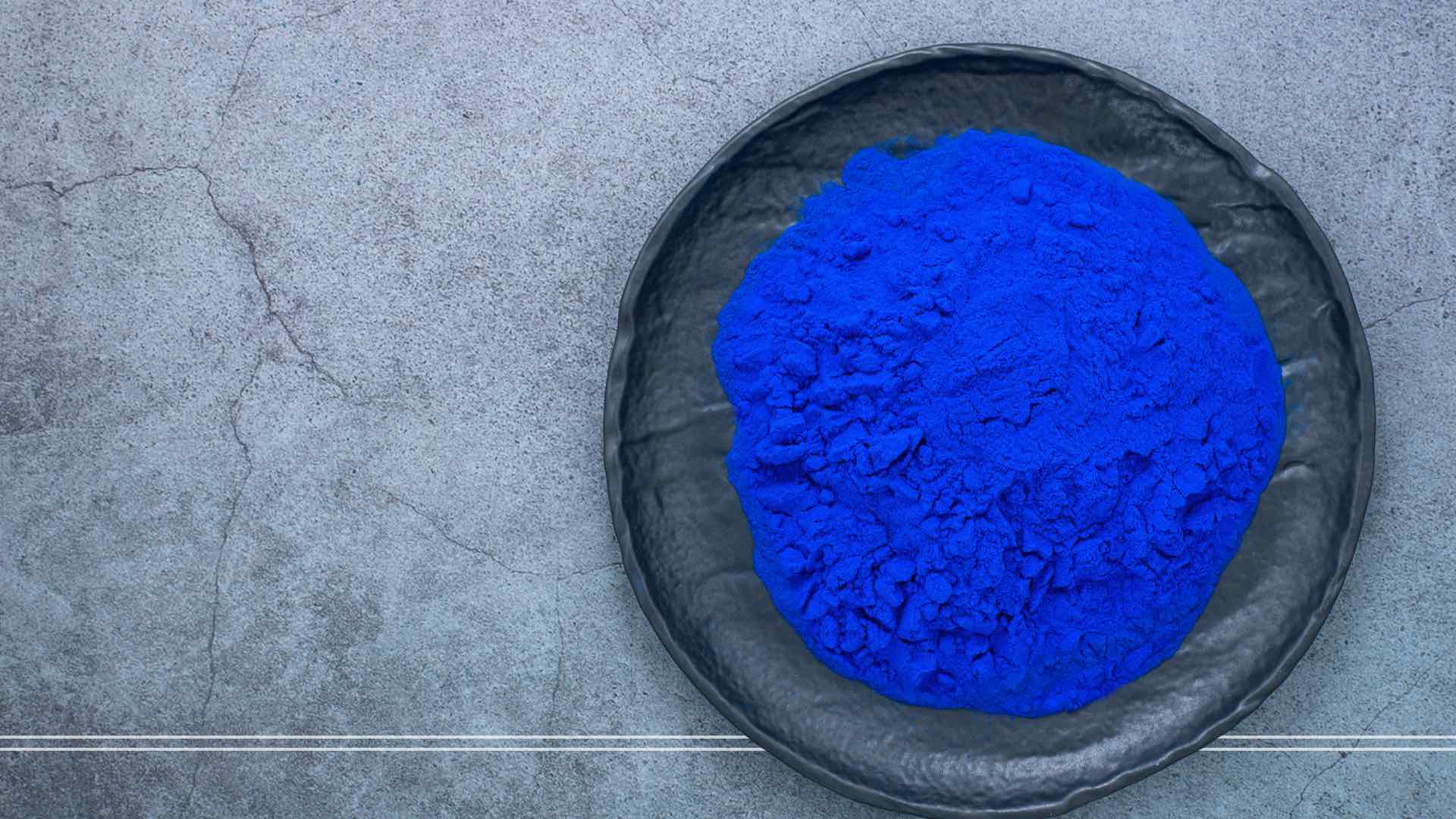Blue Spirulina: The Bright Blue Superfood You Need To Try

The sea is an often-forgotten treasure trove of superfood standouts and nutrient-rich foods. Blue spirulina, also known as phycocyanin, is one such food.
It’s a vibrant blue-green algae extract derived from Spirulina platensis, a type of cyanobacteria. This ancient microorganism has been consumed for centuries, prized for its nutritional and medicinal properties. It’s obtained through a specialized extraction process, isolating the pigment responsible for its distinctive blue color and potent health benefits.
A Quick Overview Of Blue Spirulina
Blue spirulina is an extraordinary superfood, boasting an impressive nutritional profile. It's rich in protein, vitamins (B12, A, E, K), minerals (iron, calcium, magnesium), and antioxidants. This powerhouse ingredient also contains essential fatty acids, amino acids, and other beneficial compounds. With its unique combination of nutrients and bioactive molecules, blue spirulina supports overall well-being, energy, and vitality, making it a popular supplement among health enthusiasts and functional medicine practitioners.
This is not to be confused with green spirulina, also a popular health food. While green spirulina is itself a nutrient-dense superfood, blue spirulina's elevated phycocyanin content and enhanced antioxidant properties make it an even more potent and versatile option for those seeking maximal health benefits. (plus it’s a lot prettier in smoothies!)
The Top Benefits
Aids In Cholesterol Management
Blue spirulina aids in cholesterol management in several ways: (1)
- Reduces LDL (Bad) Cholesterol:
- Phycocyanin in blue spirulina inhibits the absorption of dietary cholesterol
- Decreases LDL cholesterol production in the liver
- Increases HDL (Good) Cholesterol:
- Blue spirulina's antioxidants and fatty acids support HDL production
- Helps remove excess cholesterol from bloodstream
- Triglyceride Reduction:
- Blue spirulina's omega-3 fatty acids and antioxidants decrease triglyceride levels
- Reduces risk of heart disease
- Inhibits Cholesterol Absorption:
- Phycocyanin binds to bile acids, reducing cholesterol absorption
- Increases excretion of bile acids, lowering cholesterol levels
- Anti-Inflammatory Effects:
- Reduces inflammation in blood vessels, improving cholesterol transport
- Decreases cardiovascular risk
- Improves Lipid Profiles:
- Balances lipid metabolism
- Supports healthy cholesterol ratios
Helps Reduce Blood Pressure Levels
Blue spirulina can also be an incredible tool in helping to reduce elevated blood pressure levels. The mechanism of action is several-fold (2)
- Vasodilation:
-
- Phycocyanin relaxes blood vessels, improving blood flow
- Increases nitric oxide production, dilating blood vessels
- Endothelial Function Improvement:
-
- Enhances endothelial cells' ability to regulate blood flow
- Increases production of vasodilators (nitric oxide, prostacyclin)
- Anti-Inflammatory Effects:
-
- Reduces inflammation in blood vessels
- Decreases endothelial dysfunction, a key factor in hypertension
- Antioxidant Protection:
-
- Neutralizes free radicals, reducing oxidative stress
- Protects blood vessels from damage, promoting healthy function
- Potassium Content:
-
- Helps lower blood pressure by:
- Balancing sodium levels
- Relaxing blood vessels
- Improving kidney function
- Calcium Channel Blockade:
-
- Phycocyanin inhibits calcium influx into vascular smooth muscle
- Relaxes blood vessels, reducing blood pressure
Offers Immune Support
Blue spirulina supports immune function by directly stimulating the production of antibodies and immune cells, such as macrophages and natural killer cells, to fight off pathogens and foreign substances (germs!). (3) It also activates the body's natural killer cells and enhances the activity of cytokines, which coordinate the immune response. Blue spirulina can also provide antioxidants and anti-inflammatory compounds to protect immune cells from damage and supports the health of the gut-associated lymphoid tissue (GALT), a key component of the immune system.
This multi-pronged support helps to boost overall immune defense, increase resistance to infections and diseases, enhance recovery from illness, and support autoimmune disease management.
Rich In Nutrients
Blue spirulina is an nutrient-dense superfood rich in:
- Protein: Up to 70% protein by weight, including essential amino acids.
- Phycocyanin: A unique blue pigment with antioxidant and anti-inflammatory properties.
- Vitamins:
- Vitamin B12 (cobalamin)
- Vitamin B2 (riboflavin)
- Vitamin B1 (thiamin)
- Vitamin A (beta-carotene)
- Vitamin E (tocopherol)
- Vitamin K
- Minerals:
- Iron
- Calcium
- Magnesium
- Potassium
- Zinc
- Copper
- Manganese
- Selenium
- Antioxidants:
- Phycocyanin
- Beta-carotene
- Lutein
- Zeaxanthin
- Other carotenoids and polyphenols
- Essential Fatty Acids:
- Gamma-linolenic acid (GLA)
- Linoleic acid
- Alpha-linolenic acid (ALA)
- Other nutrients:
- Fiber
- Chlorophyll
- Sulfolipids
- Glycolipids
The Potentials
Blue spirulina has a wealth of potential benefits still in need of additional research.
- Environmental allergy protection: May help mitigate allergic responses to pollutants and toxins (4)
- Anemia prevention and treatment: Iron content may help combat anemia, particularly in vulnerable populations (5)
- Exercise performance enhancement: Antioxidants and nutrients may improve endurance, reduce fatigue, and support muscle recovery
- Neuroprotection and cognitive support: Phycocyanin may have neuroprotective effects, potentially helping with neurodegenerative diseases (6)
- Anti-aging and skin health: Antioxidants and pigments may reduce oxidative stress, promoting healthier skin and aging (7)
- Eye health and vision support: Lutein and zeaxanthin may protect against age-related macular degeneration
- Immune system modulation: May help regulate immune responses, reducing inflammation and autoimmune issues
- Cardiovascular health: May help lower blood pressure, improve lipid profiles, and prevent cardiovascular disease
- Anti-cancer properties: Phycocyanin and other compounds may exhibit anti-tumor and anti-cancer effects
- Gastrointestinal health: Prebiotic fiber and nutrients may support gut health and microbiome balance
While these potential benefits are promising, more research is needed to confirm anything concretely. In the meantime, it’s an incredible superfood to explore with the guidance of a professional functional medicine practitioner.
How To Incorporate Blue Spirulina Into Your Routine
Incorporating blue spirulina into your daily routine is easy, versatile, and often very beautiful due to its stunning natural hue. Here are some practical ways to add this superfood to your diet:
Powder Form:
- Smoothies: Mix 1-2 teaspoons with your favorite fruits, milk, or yogurt.
- Smoothie Bowls: Add a spoonful to your bowl for a vibrant, nutritious topping.
- Baked Goods: Substitute 1-2% of flour with blue spirulina powder in recipes.
- Sauces & Dressings: Blend into hummus, guacamole, or salad dressings for a nutritional boost.
- Oatmeal or Yogurt: Sprinkle on top for added nutrition.
- Juices: Mix with your favorite juices for an extra kick.
Tablet Form:
- Daily Supplement: Take 1-2 tablets with water, as recommended.
- On-the-go: Keep tablets in your bag or at your desk for a quick energy boost.
Tips:
- Make sure you’re sourcing blue spirulina (and all your supplements) from a trusted, well-vetted source
- Start small: Begin with a small dose (1/2 teaspoon or 1 tablet) and adjust to taste.
- Mix with liquids: Combine powder with liquids to avoid the strong flavor.
- Choose unsweetened: Opt for unsweetened products to avoid added sugars.
- Store properly: Keep powder and tablets in a cool, dry place.
Work with a functional medicine professional before adding blue spirulina to your diet, especially if you have allergies or sensitivities.
My favorite ways to get creative with blue spirulina
- Blue Spirulina Latte: Mix powder with milk and honey for a vibrant, healthy drink.
- Spirulina Pesto: Blend with basil, garlic, and olive oil for a nutritious sauce.
- Blue Energy Bites: Mix powder with coconut flakes, nut butter, and honey.
- Spirulina Chocolate: Combine powder with cocoa powder and coconut sugar for a healthy treat.
Precautions and Potential Side Effects
Who Should Not Take Blue Spirulina:
- Individuals with autoimmune diseases (e.g., multiple sclerosis, rheumatoid arthritis, lupus) due to potential immune system stimulation, which may worsen conditions.
- Pregnant and breastfeeding women, as algae may pose unknown risks to fetal or infant development.
- People with compromised immune systems (e.g., HIV/AIDS, undergoing chemotherapy).
- Those with severe kidney or liver disease, as spirulina may exacerbate existing conditions.
- Individuals with phenylketonuria (PKU), as spirulina contains phenylalanine.
Symptoms to Stop Taking Blue Spirulina:
- Severe allergic reactions (hives, itching, difficulty breathing)
- Gastrointestinal issues (nausea, vomiting, diarrhea, abdominal pain)
- Increased autoimmune disease symptoms
- Interactions with medications (blood thinners, immunosuppressants)
- Unexplained fatigue, weakness, or muscle pain
- Skin rashes or lesions
- Yellowing of skin or eyes (jaundice)
Precautions:
- Consult a healthcare professional before taking blue spirulina, especially if you have underlying medical conditions or take medications. Working with an expert, especially one familiar with using superfoods as medicine, is your best way to avoid unwanted side effects.
- Start with small doses and monitor your body's response.
- Ensure proper sourcing and quality control to minimize contamination risks.
- Remember, while blue spirulina offers potential benefits, it's essential to prioritize caution and consult with a healthcare professional if you're unsure about its suitability for your individual circumstances.
Taking The Next Step Towards Vibrant Health
If the idea of dosing and proper sourcing for blue spirulina sounds confusing or overwhelming, you’re not alone. It takes years of expertise to understand exactly how best to incorporate these types of superfoods into your routine for the best results depending on your unique health needs.
If you’re interested in working with our team and seeing how our expertise can best support your health goals, schedule a telehealth consultation today.
Start Your Health Journey Today
FUNCTIONAL MEDICINE CONSULTATIONS FOR PEOPLE AROUND THE WORLD
- DiNicolantonio, J. J., Bhat, A. G., & OKeefe, J. (2020). Effects of spirulina on weight loss and blood lipids: a review. Open heart, 7(1), e001003.
- Miczke, A., Szulińska, M., Hansdorfer-Korzon, R., Kręgielska-Narożna, M., Suliburska, J., Walkowiak, J., & Bogdański, P. (2016). Effects of spirulina consumption on body weight, blood pressure, and endothelial function in overweight hypertensive Caucasians: a doubleblind, placebo-controlled, randomized trial. European Review for Medical & Pharmacological Sciences, 20(1).
- Vasudevan, S. K., Seetharam, S., Dohnalek, M. H., & Cartwright, E. J. (2021). Spirulina: A daily support to our immune system. International Journal of Noncommunicable Diseases, 6(Suppl 1), S47-S54.
- Mao, T. K., Water, J. V. D., & Gershwin, M. E. (2005). Effects of a Spirulina-based dietary supplement on cytokine production from allergic rhinitis patients. Journal of Medicinal Food, 8(1), 27-30.
- Selmi, C., Leung, P. S., Fischer, L., German, B., Yang, C. Y., Kenny, T. P., ... & Gershwin, M. E. (2011). The effects of Spirulina on anemia and immune function in senior citizens. Cellular & molecular immunology, 8(3), 248-254.
- Trotta, T., Porro, C., Cianciulli, A., & Panaro, M. A. (2022). Beneficial effects of spirulina consumption on brain health. Nutrients, 14(3), 676.
Nova, M., Citterio, S., Martegani, E., & Colombo, S. (2024). Unraveling the Anti-Aging Properties of Phycocyanin from the Cyanobacterium Spirulina (Arthrospira platensis). International Journal of Molecular Sciences, 25(8), 4215.
The information on this website has not been evaluated by the Food & Drug Administration or any other medical body. We do not aim to diagnose, treat, cure or prevent any illness or disease. Information is shared for educational purposes only. You must consult your doctor before acting on any content on this website, especially if you are pregnant, nursing, taking medication, or have a medical condition.
Our content may include products that have been independently chosen and recommended by Dr. Will Cole and our editors. If you purchase something mentioned in this article, we may earn a small commission.

BY DR. WILL COLE
Dr. Will Cole, DNM, IFMCP, DC is a leading functional medicine expert who consults people around the globe, starting one of the first functional medicine telehealth centers in the world. Named one of the top 50 functional and integrative doctors in the nation, Dr. Will Cole provides a functional medicine approach for thyroid issues, autoimmune conditions, hormonal imbalances, digestive disorders, and brain problems. He is also the host of the popular The Art of Being Well podcast and the New York Times bestselling author of Intuitive Fasting, Ketotarian, Gut Feelings, and The Inflammation Spectrum.

Gut Feelings
Healing The Shame-Fueled Relationship
Between What You Eat And How You Feel
